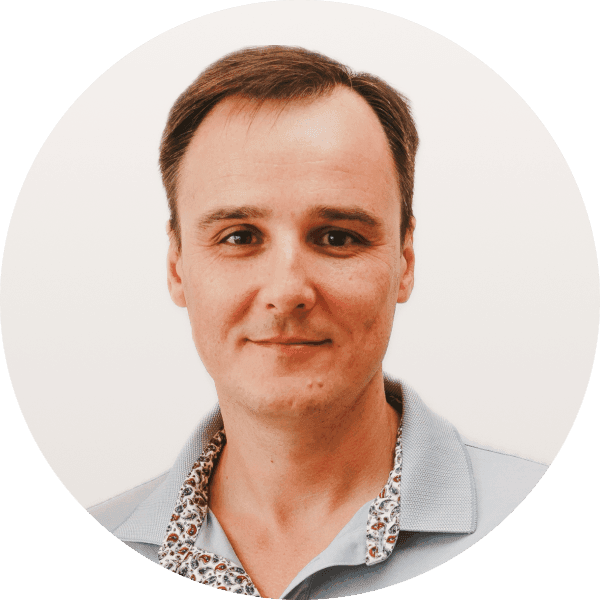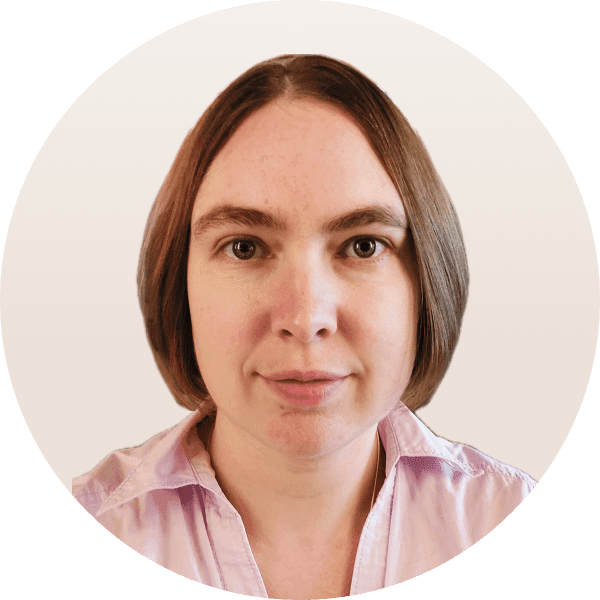Today, many healthcare services have become more accessible with apps. Such solutions ease our lives with prompt appointment scheduling, immediate access to healthcare records, and convenient billing options. Healthcare mobile apps also assist in education for patients and medical professionals.
So, healthcare mobile app development is a viable idea. But you need to consider certain essential aspects that will help you create a functional solution.
This article gives a profound analysis of the key aspects that are vital for healthcare mobile app development. Read on to identify what they are to make your healthcare app delightful for the target audience.
Healthcare app: definition
A healthcare app is a software tool for mobile devices that helps users send data and monitor their health. Healthcare apps help users get medical advice and keep electronic health records (EHRs). They also help submit insurance claims.
With the healthcare mobile app, you can monitor key health metrics. These are calorie intake, physical activity, blood pressure, blood glucose levels, etc.
Health app vs medical app
There are different types of apps in the healthcare industry that help people. For example, people can use these apps to maintain their health and track their conditions. These apps fall into two main categories: health and medical apps.
People download such apps on smartphones, tablets, or desktops. The most common types of health apps include the following:
- Physical activity monitoring;
- Sleep pattern tracking;
- Stress management tracking;
- Nutrition and calorie counting.
On the other hand, medical apps connect patients and healthcare facilities or are created as guides for doctors. These apps serve the following purposes:
- Telemedicine;
- Remote patient monitoring;
- EHRs access;
- Chronic disease management;
- Simplifying the consultation process;
- Educating medical professionals.
In this article, we use the term health or healthcare app both for general health apps and medical apps.
Why is healthcare app development vital in 2026?
Digitalization in healthcare has become a priority due to the advantages it provides in monitoring health. There are a few reasons for that. Let’s examine why patients and doctors win from using healthcare apps.
Receive immediate access to healthcare. Healthcare apps can be accessed from anywhere and through any device. You can reach a healthcare facility or a doctor 24/7 or as soon as possible. It enables remote health monitoring from home, which is vital for the elderly and people with limited physical mobility.
Easily track users’ health. Mobile health apps help track the physical and mental state of users. Health apps allow setting plans and tracking calorie and water intake personalized to individual needs. By tracking physical and mental health, users can get support, for instance, medical advice from their therapist.
Improve the treatment process. An app allows physicians to access patients’ data in near real-time. So, the treatment process becomes faster and more accurate. Physicians take corrective measures if needed as soon as possible. Also, patients become more engaged in the treatment process as it is easy for them to adhere to the treatment plan with an app.
Reduce costs for medical services. Healthcare apps help to automate and streamline medical consultation processes. They include billing, scheduling appointments, and filling prescriptions. Patients can directly send their data, such as insurance cards. This will reduce the paperwork that doctors need to do.
Moreover, with the help of these apps, hospitals can serve patients without their visits. This will decrease the need for human resources and the clinic's management costs.
Help prevent legal issues. Healthcare apps are created under regulations on patients’ data security. Also, the electronic turnover of health records makes access to patients’ information easier and more accurate. This reduces the risk of legal errors and loss of reimbursements for individuals.
Healthcare app market overview and stats
Though we have passed the surge of mobile health (mHealth) apps during recent years, the forecast for the industry is still optimistic. As of 2024, over 65,300 mHealth apps were in the Google Play Store and 54,000 on the Apple App Store.
As healthcare implements digital tools, the mHealth app market size is expected to grow. The mHealth app market was valued at $36.68 billion in 2024. It is expected to grow at a compound annual growth rate of 11.8% from 2025 to 2032.
The significant factors projected to drive the healthcare mobile application market are as follows:
- Promoting the adoption of healthcare apps by governmental and private organizations;
- Continuous improvement of healthcare apps by developers;
- Demand for distant patient monitoring and popularity of monitoring apps among customers;
- Expanding usage of social media with app promotions.
The active adoption of mHealth apps helps people connect to physicians quickly. People turn to healthcare mobile app development services mainly to monitor their health state and get medication reminders, mental health support, virtual consultations, and nutrition and fitness tracking.
However, the factor that poses risks is the security and data privacy of such apps. That is why your mHealth app must use the best digital security practices and comply with data protection standards. See the section on compliances below in this post.
Types of healthcare apps
Despite the diversity of healthcare apps, there are two main types of them. The healthcare apps are developed for doctors and patients. Let’s find out what they are and how they help users monitor their health and do medical work.
Professional healthcare apps for doctors
These apps are helpful for doctors, nurses, physicians, and other staff in medical organizations. So, they include advanced features and are adapted to handle complex tasks for medical workers.
Medical record apps
These are the typical medical apps available on the market. These apps can be used to collect and record information about a patient's health. The app allows a doctor to record data on physical indicators, family history, chronic diseases, and current conditions. Also, a doctor can record the data on examinations, appointments, and prescriptions.
- Intergy;
- Medicapp Pro.
Medical prescription apps
These apps let doctors select the right drugs for a patient and wrap them in a list. The apps help prescribe the drugs in the right dosage and cancel them at any time. If necessary, you can print the prescription and show it to a pharmacy. The following are examples of prescription apps.
- STAT;
- RxEasy;
- GoodRx.
Billing apps
Such apps help medical professionals steer the processes of charging fees. Also, they help manage claims, do accounting, and process payments. Top billing apps include the following:
- Pabau;
- Jane.
Electronic history/medical records
Typically, mobile medical apps allow you to streamline the process of keeping records and billing for medical facilities. Thus, the healthcare application combines the functions of keeping records and taking charges.
Today, health apps have the functionality of keeping patient records as default. It combines with billing options. Such a combination allows doctors to have the necessary information on hand. The apps keep records of patients’ physical data, chronic diseases, and current conditions. Also, the healthcare application provides information on the current medical treatment and family history.
Moreover, the apps allow you to charge and record the collected fees. So, you can make invoices, manage claims, and do accounting. You can choose between the following popular solutions:
- DrChrono;
- CureMD Avalon;
- CareCloud.
Telehealth apps
These apps allow doctors to make appointments and provide consultations to users via in-app messages or video calls. Telemedicine apps help reduce “no-shows” by 50%. Also, clients can receive the consultation while they are at home. The popular telehealth apps are the following:
- Amwell;
- ViTelNet;
- Caregility;
- VisualDx.
For instance, VisualDx is a healthcare mobile app that helps doctors make accurate diagnoses with a rich database of images collected over 20 years. It allows doctors to verify their diagnoses in dermatology, internal medicine, pediatrics, and more.
The data gathered in the health mobile app includes summaries of more than 3,200 diagnoses. VisualDx allows doctors to review patients’ histories, allergies, and recent travels. This helps to provide an accurate and unbiased diagnosis.
Medical networking
Physicians and nurses must keep up with the latest medical trends and keep their knowledge as fresh as possible. Networking and communication on social media are one of the means to follow the recent medical trends. The popular networking apps for medical staff are the following:
- Doximity;
- Sermo;
- UpToDate;
- Epocrates.
The Epocrates app integrates many features that doctors, nurses, pharmacists, and medical students can use to help in their practice. It includes a wide range of research pieces and discoveries. Epocrates provides doctors with Symptom Checker, Disease Database, Drug References, and Medicine Specific Calculator, to name a few. Doctors can connect with each other through an app using the service called Athena Text.
Another advantage of the app is that it can work offline. So, doctors can use it even with a poor Internet connection. Currently, over one million specialists use the app.
Healthcare apps for patients
Healthcare mobile apps for patients help assess the key physical indicators. Such apps are diverse and help users understand their health state. Also, the apps contain recommendations on wellness. Let’s see what the types of patient apps are and how they assist users in monitoring their health.
Health monitoring
These apps are designed for remote patient monitoring. They can check symptoms, prompt medication intake, or give treatment advice. They can also help track chronic conditions like cancer and diabetes.
- Ada;
- Welltory;
- Ornament;
- Teladoc.
Teladoc is a leading telehealth and telemedicine app, which provides mobile healthcare help 24/7 globally. You can talk with certified specialists about the common symptoms. For example, discuss symptoms of cold or flu, skin issues, mental or psychological aspects, and nutrition.
The process of contacting a doctor is streamlined, and the costs are kept transparent. The app integrates with Apple’s HealthKit, enabling patients to upload their physical data for review to Teladoc’s specialists. Teladoc offers its app for patients, healthcare vendors, and doctors.
- MyChart.
MyChart is one of the most popular apps for patients and has been downloaded over 10 million times on the Google App Store. It is a comprehensive healthcare mobile app that offers a vast spectrum of services. You can handle the information that you provide and get during your visits to medical facilities.
With the app, you can communicate with the healthcare team and get appointments for in-person and video visits. The app shows examination results, prescriptions, and medical history.
The app also has the advantage of allowing you to connect with many healthcare facilities. The only necessity here is that the facilities should support using MyChart. The app also integrates with a popular GoogleFit app. So you can retrieve your health data from GoogleFit and send it to MyChart.

Source: MyChart app on Google Play Store
Medication tracking apps
Medication trackers are quite widespread due to their simplicity and usefulness. Such apps help people to take their medication on time by scheduling and reminding them. Also, they monitor drugs in the local pharmacies and help find the cheapest ones. You can select the following apps that users appreciate:
- ScriptSave WellRX;
- Medisafe Pill Reminder;
- MyTherapy Pill Reminder;
- Dosecast.
Mental health apps
Mental healthcare applications aim to help users access therapy in the comfort of their homes or wherever they need it. The apps contain relaxing meditations and breathing exercises. They help cope with stress, anxiety, and sleep disorders.
Such healthcare mobile apps help detect behavior changes and signal the need for help. Also, they will connect you with a peer counselor or health care specialist. The apps that people enjoy using are as follows:
- Talkspace;
- iBreathe;
- Calm.
Fitness apps
These apps provide fitness tracking features to promote a healthy lifestyle. Many fitness apps use AI to suggest personal plans based on user goals, health data, and lifestyle. Health and fitness apps help you monitor heart rate, count steps, and track sleep.
Besides a direct tracking of physical activity, such apps include tips and tracking of diet, hydration, and mental well-being. For example, popular fitness tracking apps include the following:
- Nike Training Club;
- Strava;
- Peloton.
Wellness apps
This group embraces healthy lifestyle apps that help you stay fit and healthy. With the wellness app for patients, you can choose body and brain exercises and self-improvement habits. You can choose between the following prominent apps:
- Remente;
- BetterMe;
- FollowMyHealth.
The FollowMyHealth healthcare mobile app has the necessary functionality to take active care of your health. Many patients and physicians use the app to handle healthcare activities. With the app, you can schedule and change appointments and fill in pre-appointment information.
FollowMyHealth provides a secure environment to review medical records and view test and lab results. You can update your personal information in this healthcare mobile app at any time. Also, the app allows you to view and pay bills.
- MindPal - Brain Training.
Nutrition apps
These apps help you plan and maintain healthy nutrition habits. Essential features for such apps include calorie counters, menu planning, and recipe databases. Also, such apps may include a food scanning feature that counts the calories of the food you are eating. The apps people trust include the following:
- MyFitnessPal: Calorie Counter;
- Lifesum: Healthy Eating and Diet;
- Calorie Counter App: Fooducate.
Medical education apps
These apps create an up-to-date database for doctors, students, and users who want to know more about healthcare. Medical education apps include virtual classes, online assessments, gamification, and other features. Notable examples of such apps include the following:
- Medscape;
- Lecturio Medical Education;
- MedLearn Pro.
Compliances for healthcare apps: local and international guidelines
The factors that hold back the mHealth market include security concerns and data privacy. As mHealth apps store people’s health data, the risks of data leaks should be minimized. The leaks can be in the following forms:
- Unauthorized data access;
- Hacking;
- Data breaches;
- Malware programs.
Also, mHealth apps need to be approved by relevant organizations in the healthcare industry for compliance with regulations. The tech side of the healthcare application must ensure data security. This factor hampers the market growth as it takes time and costs to develop a complying app and get approval for it.
Health mobile app development requires strict compliance with local and international regulations. Such compliances ensure secure app functioning and data confidentiality. The following is the list of regulations that apply to healthcare applications.
HIPAA. This standard applies to the apps that transmit, record, and keep protected healthcare information (PHI). Such apps, created for the United States market, must comply with this standard. This standard has protected healthcare data confidentiality, integrity, and accessibility since 1996.
Below you can see what main requirements must HIPAA compliant app meet.
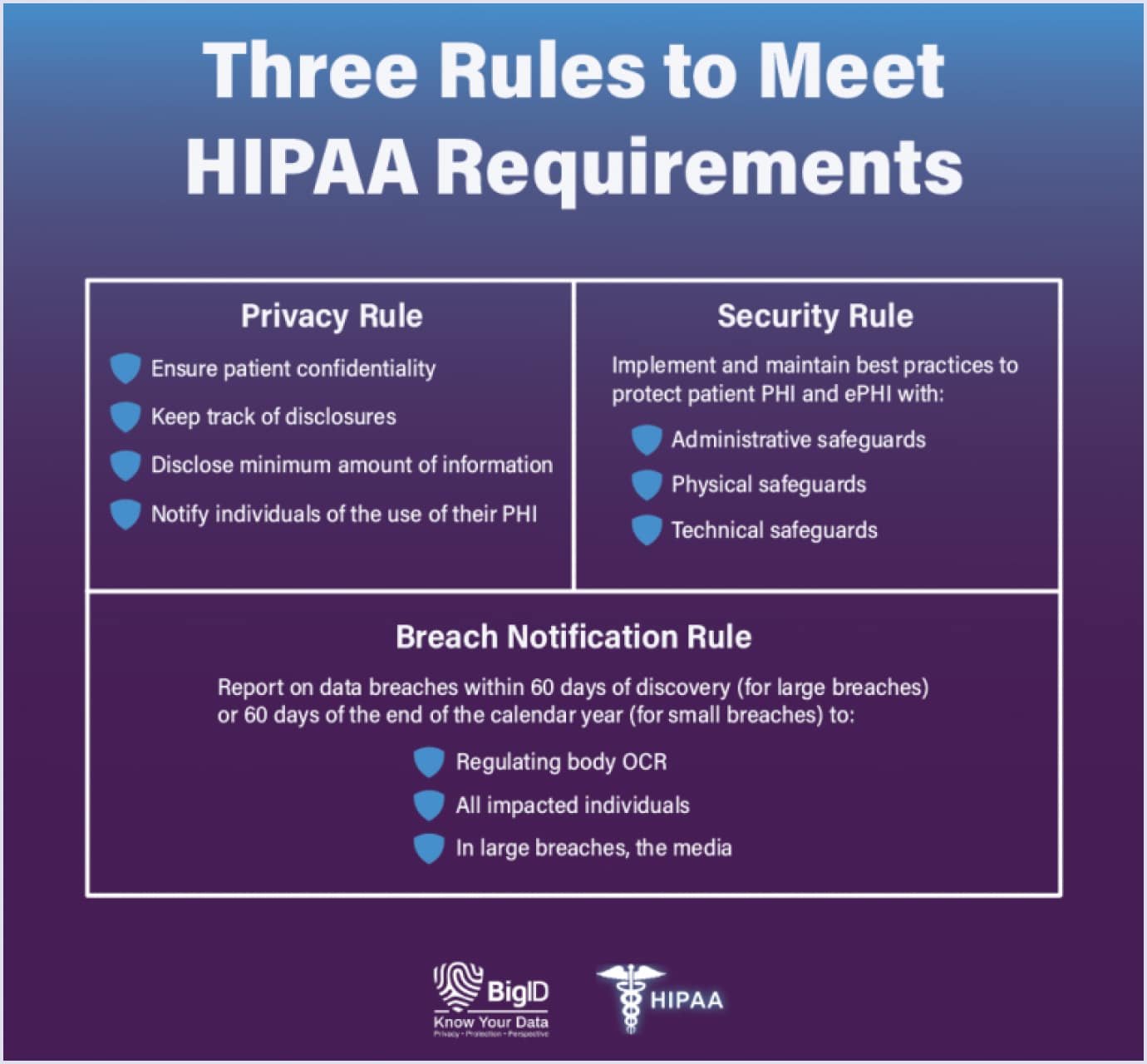
Source: Bigid.com
HiTECH. These regulations have been adopted in the United States and strengthened the HIPAA standard. HiTECH incentivized the wider introduction of electronic healthcare records in healthcare facilities. Thus, the standard advanced healthcare and improved care coordination.
CCPA. This United States act regulates how organizations collect, process, and delete personal information. This act is similar to the European GDPR. Under CCPA, you can request information on what data are collected and how it is processed and stored. Also, you can request that the organization deletes your data.
PIPEDA. This is an act adopted in Canada relating to data privacy. The standard helps to secure users’ data stored in the apps. It requires that healthcare apps encrypt the data transmission and provide reliable authentication. The data under this act must be collected with users' consent.
GDPR. These rules were introduced in the European Union in 2018 to protect personal data. Thus, apps used in the European Union must comply with this regulation. The important note is that the regulation applies both to companies that collect personal data and companies that process it.
DPA. This act applies to healthcare apps operating in the United Kingdom. The act supplements GDPR and protects personal data gathered, processed, and stored in development. It regulates the conditions before collecting personal data and third-party access to such data.
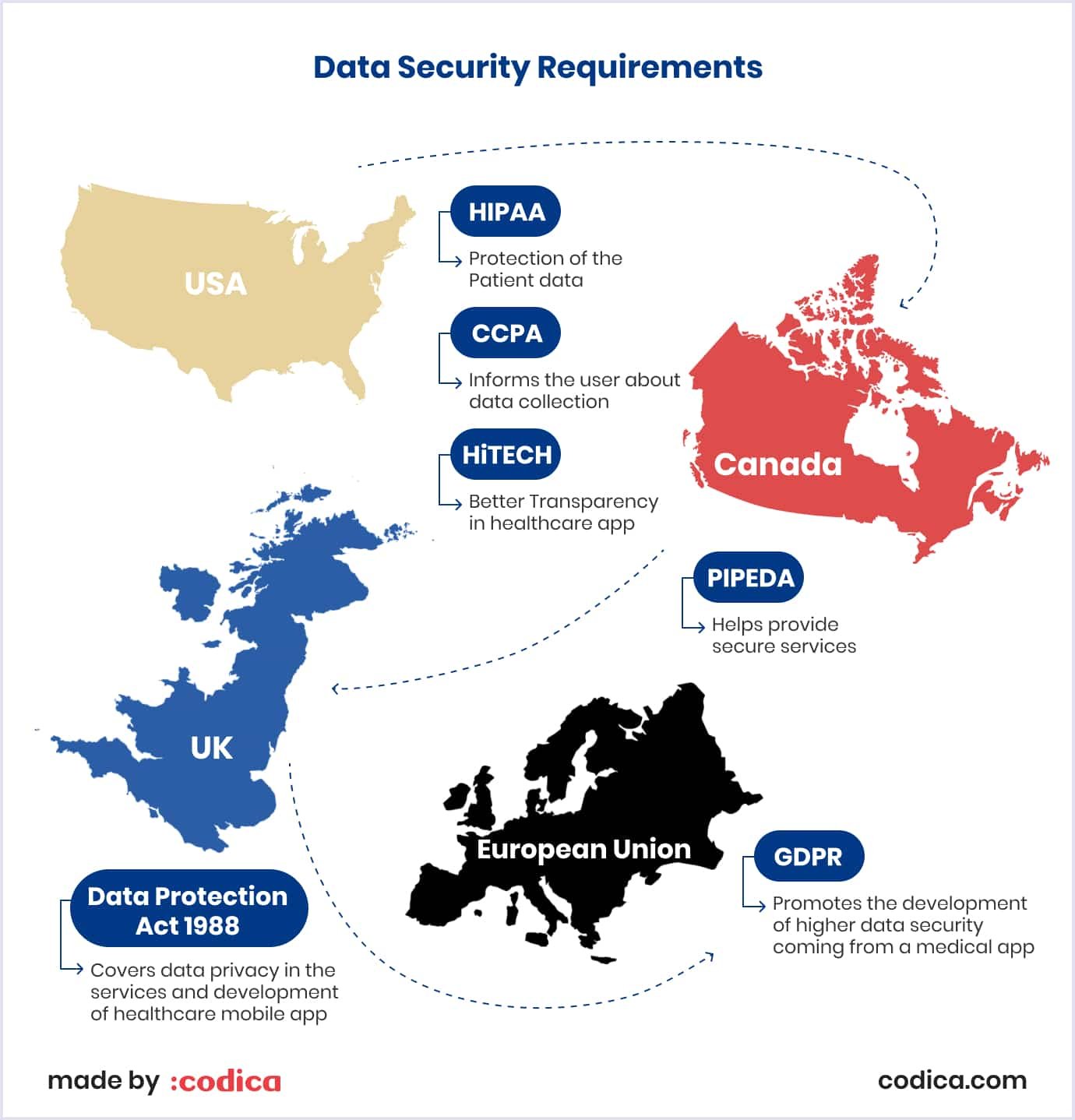
Healthcare app features
Despite the diversity of healthcare applications serving different purposes, there are certain features that make such apps helpful for users. Let’s look more closely at what they are.
Typical healthcare app features
There are some basic and popular features for your health app. But what exactly are we talking about?
Convenient registration and login
The login feature allows users to promptly input their information and, thus, reduces waiting time for an appointment. The login feature in your app should be streamlined to deliver the best user experience. Login and registration should allow users to input any information to create and access their profiles easily.
For example, below is a registration form for referral management software created by Codica. As it works in Israel, its login form is in Hebrew.

Doctor profile search
The healthcare mobile app that you create should provide an opportunity for individuals to choose the doctor they want to see. The doctor profile lookup feature is necessary if your app offers in-person registration or virtual appointments.
Thus, patients will look through the doctor’s credentials. Also, they can choose a professional based on reviews from other users. Including geolocation will help patients to choose a doctor in the vicinity depending on their location.
Appointment booking
Appointment scheduling is one of the core features of your healthcare app. It allows patients and doctors to select, change, or cancel an appointment, saving time for the scheduling process.
The app should show the free slots for an appointment from which patients can choose the convenient one. When a physician or an admin approves the appointment, a patient gets confirmation. For example, this feature is the core of the Zocdoc app.
Reminders and notifications
In-app reminders and push notifications are essential features that you should implement in your app. They are helpful but should not be intrusive. When you do them correctly, reminders and notifications improve user experience. For example, they remind users about appointments.
Also, you can preset reminders and help patients take their medication on time. Such nuance will enhance the healthcare process.
Video conferencing for doctor and patient
Virtual consultations have gone mainstream in the form of telemedicine. Many hospitals and healthcare professionals move to this form of communication with patients. Thus, the secure audio and video consultation feature is a useful tool for your app.
Also, you can add a feature for accessing patients’ history records during consultation. This way, you will bring the efficiency of the healthcare process to a new level.
Note that data collection, storage, and exchange must comply with HIPAA or another applicable standard.
Symptom checker
This feature allows patients to check typical symptoms with the healthcare mobile app. The comprehensive database of verified medical information makes the checker a valuable tool. Techno-savvy users will enjoy it.
AI-powered chatbots and in-app chats
Introducing chatbots with artificial intelligence will assist patients in first-level medical care. Regarding the symptoms, chatbots with AI and machine learning will define the next actions for a patient.
Also, a chatbot can offer to book an appointment with a doctor if needed. If a patient does not want to schedule an appointment, a chatbot can lead them to a chat with a medical specialist.
You can enrich chats with a file-sharing feature. Patients can send clinical test results and reports to practitioners. This will facilitate the diagnosing process.
For example, the Woebot chatbot helps to maintain emotional health.
Integration with electronic health records (EHR/EMR)
Access to medical history data with an app allows doctors and patients to see their data immediately. Electronic healthcare records keep track of the treatment process. For this, they comprise laboratory tests, radiographic pictures, and medication history. It means that patients’ data are processed promptly and gathered at one point.
Viewing EHR in the app saves doctors time when diagnosing patients. Also, access to medical records is useful when a patient needs to be referred to a professional.
Integration with medical devices
Data drives the future of healthcare apps. Data collected by medical devices empowers physicians when they determine the treatment.
The medical devices and app integration is helpful with a dashboard feature. It helps doctors and specialists view the health results. When patients see the data on the medical device, they better understand their health state. This way, they become more engaged in the treatment process.
Prescriptions and pharmacy lookup
The ePrescription feature allows physicians to create and send prescriptions to patients via the app. They show the needed medicine and dosage clearly.
Also, you can add a pharmacy lookup feature. It can help patients check drug availability in a pharmacy. Also, patients can see the information on drug interactions and possible side effects.
Billing and payments
These features allow patients to pay for consultations with doctors. Still, pay attention to the fact that they require strict encryption and implementation of high-security systems. This will ensure safe connectivity when a user pays for a consultation with a doctor or laboratory tests.
For example, the Kareo app helps doctors by automating billing. Thus, patients get timely statements within a 90-day timeline. The app also provides a convenient dashboard highlighting delivery statuses and collected amounts.
Patient community
Including discussion, the feature enhances patients’ engagement in the treatment process. The community feature allows users to share information on common issues. For example, this can be coping with chronic or other continuous conditions. Thus, the feature improves treatment outcomes.
Health education
This feature in healthcare application development allows patients to access wide information on health and well-being. App users can read about the human body, mental health, exercise, and nutrition.
The apps can also provide up-to-date medical information to doctors ensuring continuous education. You can include terminology, medical references, and access to medical literature and journals. This is useful for medical students and practitioners.
Monetization models for healthcare apps
Mobile healthcare apps have several revenue sources. Below are the three common monetization models for healthcare apps:
Freemium model. The freemium model is excellent for attracting users as you offer your health app for free. Yet, you also need to introduce advanced paid features that will bring you revenue. Payment can be one-time or subscription-based. To make this model work best for you, limit free trials to a specific period and send offers to upgrade regularly but non-intrusively. Also, explore the usage patterns to identify promising conversions. The prominent healthcare applications using the freemium model are Fitbit, Lifesum, and MyFitnessPal.
Subscription model. The subscription model is the most flexible compared to other revenue methods. This revenue model is useful because many health and medical apps connect patients and doctors. For example, you can charge a fee monthly, quarterly, or yearly for using your app. Doxy.me and StedyMD are the prominent apps that use a subscription model.
Advertising. This app monetization method is a popular choice as it takes the least effort to implement. Still, make sure that you offer personalized and helpful ads. Also, you can use RFID (radio-frequency identification), NFC (near-field communication), and beacon transmitters. These technologies help to produce targeted mobile ads according to your users’ location. For example, being near a pharmacy with a beacon, a user can get a notification on discounts for the medicine they often buy. For example, MyTherapy is a successful healthcare application that uses in-app ads.
If you want to explore how you can monetize your healthcare app, check out our article for a deep dive into mobile app monetization.
Additional functionality in health apps
As of 2026, the healthcare app industry has functionality that will improve healthcare apps’ usability. These features in your healthcare mobile app help doctors make correct diagnoses and define treatments, as well as improve medical service. Also, you can improve engagement rates among the target audience.

Let’s discover what advanced features of healthcare apps are and how they can improve user experience.
Interoperability
It means that a healthcare application can work on different devices. Interoperability helps patients make smarter medical decisions and achieve better treatment outcomes. However, this also involves care about patient data that institutions not covered by HIPAA or other standards must transmit.
So, this means challenges as the apps still must be secure and provide the best user experience. This approach ensures that patients will be able to receive medical care remotely if they need it.
Telemedicine
Telemedicine apps have been used over recent years and proved their profitability. The main drivers for using telehealth apps are the high costs of traditional medicine and the increase in the number of digital health users.
An estimated 127.2 million people worldwide turned to online doctor consultations in 2025, up from around 57.65 million in 2019. In fact, people in the US prefer virtual consultations for prescription refills and minor illnesses.
Telemedical apps cannot replace traditional medical services. However, they are useful for common cases and prescriptions. Thanks to the online exchange of information, patients do not have to visit a clinic physically. This saves patients' and doctors' time, so critical patients receive consultation sooner.
To make your telemedical app helpful, consider the following features:
- Video and audio consultations: patients can schedule a virtual doctor consultation online where it is possible. Such consultations usually help patients get follow-up information, repeated prescriptions, or preliminary information when unsure where to start with particular symptoms.
- In-app messaging: ensures that patients can text their healthcare providers for quick questions, follow-ups, or easy issues. Thus, communication is easy and swift.
- Appointment scheduling and reminders: helps patients book, reschedule, or cancel online healthcare services within the app. Also, include reminders as they help reduce missed appointments and improve the efficiency of care.
- Patient health records (PHR): includes storing digital health records and remote patient monitoring. Thus, patients and doctors can access health histories with the necessary documentation in one place.
- E-prescription and pharmacy integration: this feature helps doctors prescribe medications digitally. Then, prescriptions can be sent directly to pharmacies for pickup or delivery. So, patients save their time and effort in getting medicine.
- Billing and payment processing: integrated billing features help you pay for services through the app. The feature can include support for insurance processing or co-pays where applicable.
- AI-powered symptom checker: an interactive symptom checker helps patients determine if they need to see a provider or use self-care measures.
Medical equipment integration
Integrating the app with medical equipment is a unique process and depends on the type of software and facility. After that, doctors can access the latest patient data on their health conditions.
Integration can be made using API transmitting health information from users’ wearable devices. Thus, doctors will be informed on time of the patient's condition with a healthcare application. The connection also can be made with health monitoring devices like blood sugar meters, pace monitors, or pulsimeters.
Gamification
As healthcare apps rise, they must stay engaging for users. It helps users care about themselves and make your app unique.
So, what is gamification? It is an approach to using game techniques in non-gaming apps. This method helps users achieve the set goals and keep them engaged with the healthcare mobile app. According to a survey by Open Loyalty, gamification is the primary driver of user engagement, surpassing automation and partner-based marketing.
Game elements do more than entertain users. There are a few aspects that make their mission meaningful. Gamification is useful for a healthcare app because it brings the following benefits:
- Raising user engagement and motivation;
- Attracting new customers;
- Improving the state of health.
For example, you can grant your user points for timely medication intake and finishing attending sessions. Also, you can offer discounts or free-of-charge examinations. Thus, the treatment process will be pleasant and satisfying for users of any age, from the youngest to elderly patients.
An interesting instance of gamification is the Loóna app, which helps you get the right mood for sleep. It offers to tap on light boxes and see further steps. Completing them helps you feel less stressed before bedtime.

Source: Loóna app on Apple App Store
Artificial intelligence (AI)
AI ensures the processing of large volumes of information and provides large knowledge databases. AI services help doctors diagnose patients. AI also gives medical advice to patients and offers virtual nurse assistance.
Also, AI is used in mental healthcare applications. Such apps include engaging events and games led by an AI instructor. AI is also used in chatbots to help cope with interpersonal challenges. Thus, AI-powered apps can be used as an additional tool for mental health counseling.
The examples of AI usage for a healthcare app include the following instances:
- AI-powered symptom checkers: symptom checkers with AI can analyze symptoms from patients. They suggest possible causes and ease diagnostics. Examples include WebMD, Symptomate, and Buoy.
- Predictive healthcare analytics for patient monitoring: AI can analyze real-time data that come from wearable devices and patient health records. So, AI can predict health risks and help doctors to take measures in time. Thus, the devices alert patients of potential issues and help them take proper steps.
- Medical imaging analysis: healthcare apps can be connected with imaging services, such as X-rays and MRIs. So, specialists will see abnormalities faster thanks to medical imaging AI. For example, radiologists use imaging apps such as Viz.ai, Aidoc, and Qure.ai. Such apps help with early diagnosis thanks to outlining patterns in medical images.
- Personalized treatment plans: AI can analyze patient’s data and suggest customized care plans and treatment options. Moreover, personalized medicine apps use AI to help doctors customize treatments. Often, it includes treatment of chronic diseases.
- Drug interaction warnings: AI-powered tools can analyze prescribed medications. Upon such an analysis, the healthcare app with AI alerts users and doctors about potential adverse drug interactions based on a patient’s history. This is particularly valuable in apps for chronic disease management as, in this case, patients may take multiple medications.
- Remote patient monitoring: AI can improve remote tracking of the health state thanks to analyzing streams of data from wearables. So, AI alerts healthcare providers when anomalies occur. This feature supports telemedicine apps and allows doctors to keep track of high-risk patients remotely.
- Voice recognition for accessibility: voice-enabled AI allows patients to interact with healthcare apps hands-free. Thus, users with disabilities can access features like symptom checking, medication reminders, and more.
Virtual waiting rooms
This feature designs a waiting room for patients. It can be accessed via the healthcare application installed on a mobile device. When it’s time for an appointment, a user gets a notification that it’s time to enter. A user must complete a verification process to come in. After that, a patient enters and waits for the appointment.
It is similar to apps that allow the holding of virtual meetings, like Zoom. Crowded waiting rooms on healthcare premises are far from hygiene. So, it is useful to create in-app waiting rooms to minimize the risk of spreading diseases. Building a virtual waiting room is useful both for patients and doctors.
Internet of Things (IoT)
Smart wearable devices are the best examples of using IoT in healthcare app development. Wearables help gather physical data from users. It can be helpful for people with life-threatening diseases and those who cannot inform caregivers promptly.
Wearables have become popular recently with the common shift to a healthy lifestyle. Fitness bracelets connect with smartphones. They work with Windows, iOS and Android. They help their owners count steps, calories, and water intake. Also, these bracelets measure heart rate, blood pressure, and sleep quality.
Blockchain for EHR
EHRs have been a priority in healthcare since they hold valuable patient data. Blockchain technology allows EHR to be safer and protected against data change. This helps track healthcare records and avoid mistakes. So, healthcare facilities can track the patients’ conditions and help them choose the right treatment.
RefDental functionality
Healthcare apps serve different purposes and are diverse in use. What they all have in common is that they help streamline the work of professionals in medical facilities. This was the case with Codica’s development of referral management software.
The solution aimed to ease the process of sending referrals to the digital imaging center from clinics. Our development team created the system as a minimum viable product. After the customer tested it with early users, we added more functionality that improved the user experience. Let's take a closer look at the features of this advanced web application.
Clinic profile management
The system allows new clinics to register and sign up. After this, clinics can change the details in their profiles. The sign-in option also includes the possibility of recovering a forgotten password. Also, with this feature, the clinic can change its profile if needed.
Referral form filling-up
Clinics fill in the form that is to be sent to the dental imaging center. The form requires you to fill in the patient’s and clinic’s details. Optionally, the clinic can indicate the imaging type and hard copies of documents in the checkbox.
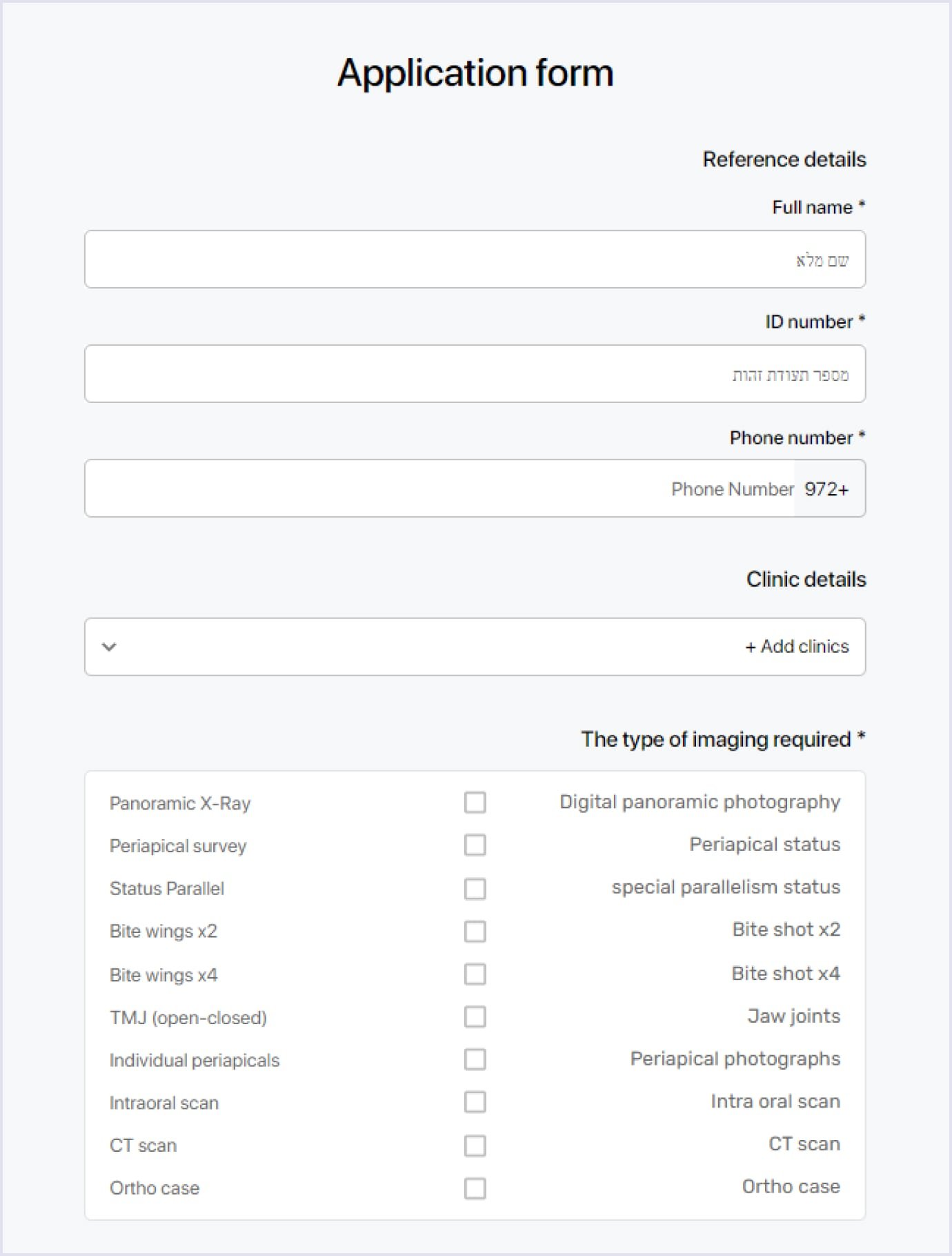
Uploading and viewing patient’s images
The PWA has a simple form with several fields that reflect the patient’s details, such as the insurance ID number. Thus, the form helps to verify that the referral request is legitimate. After receiving this form, the center approves or disapproves the referral. Also, this feature enables the center to view images full-screen.
Dashboard for the dental imaging center
The dashboard includes administrative features. The center can use them to manage patient referrals. The dashboard allows the center to see patients’ details, change the image status to completed, and approve image requests. Also, the center can give access to clinics enabling them to view images.
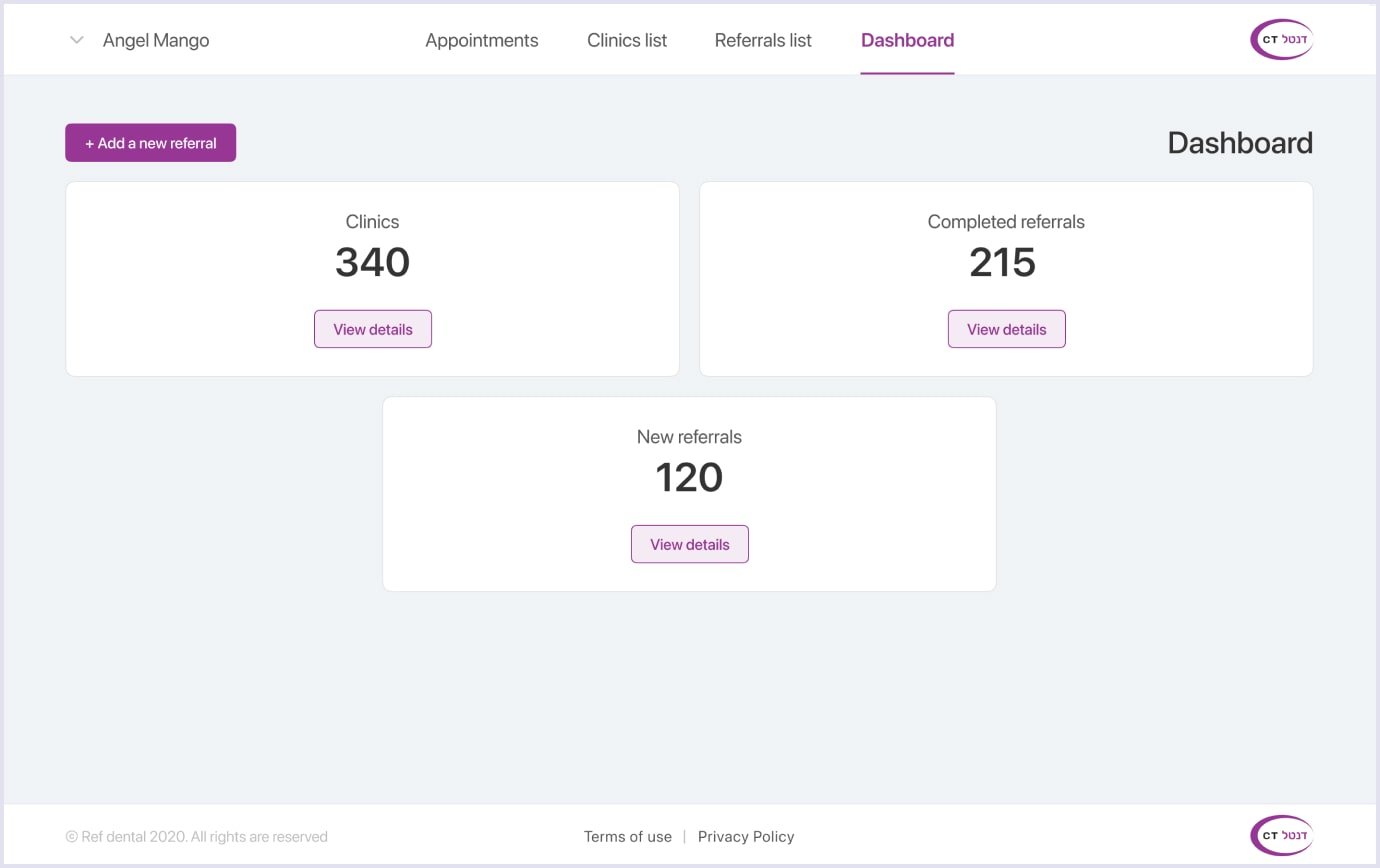
Right-to-left input of information
As the center is located in Israel, we implemented the right-to-left input of information. So, Israeli users have an excellent experience with using the system in the Hebrew language.
Responsive interface
The Codica team created a responsive system for different types of devices. So, the PWA can be used both on desktops and mobile devices with the same quality of operation.
Below is a video presenting the core functionality of this referral management software.
Choosing a healthcare app development partner
At Codica, we have more than seven years of experience in delivering successful mobile app development services. We also can help you with healthcare app development. But how can we do this?
The Codica team uses the agile methodology to create highly-performed and lucrative web products. Agile is a flexible management system, the best suited for IT. Applying the agile method means dividing the project into short cycles, called sprints. At the end of the sprint, the client obtains a certain product.
Below is a diagram that shows our software development life cycle.
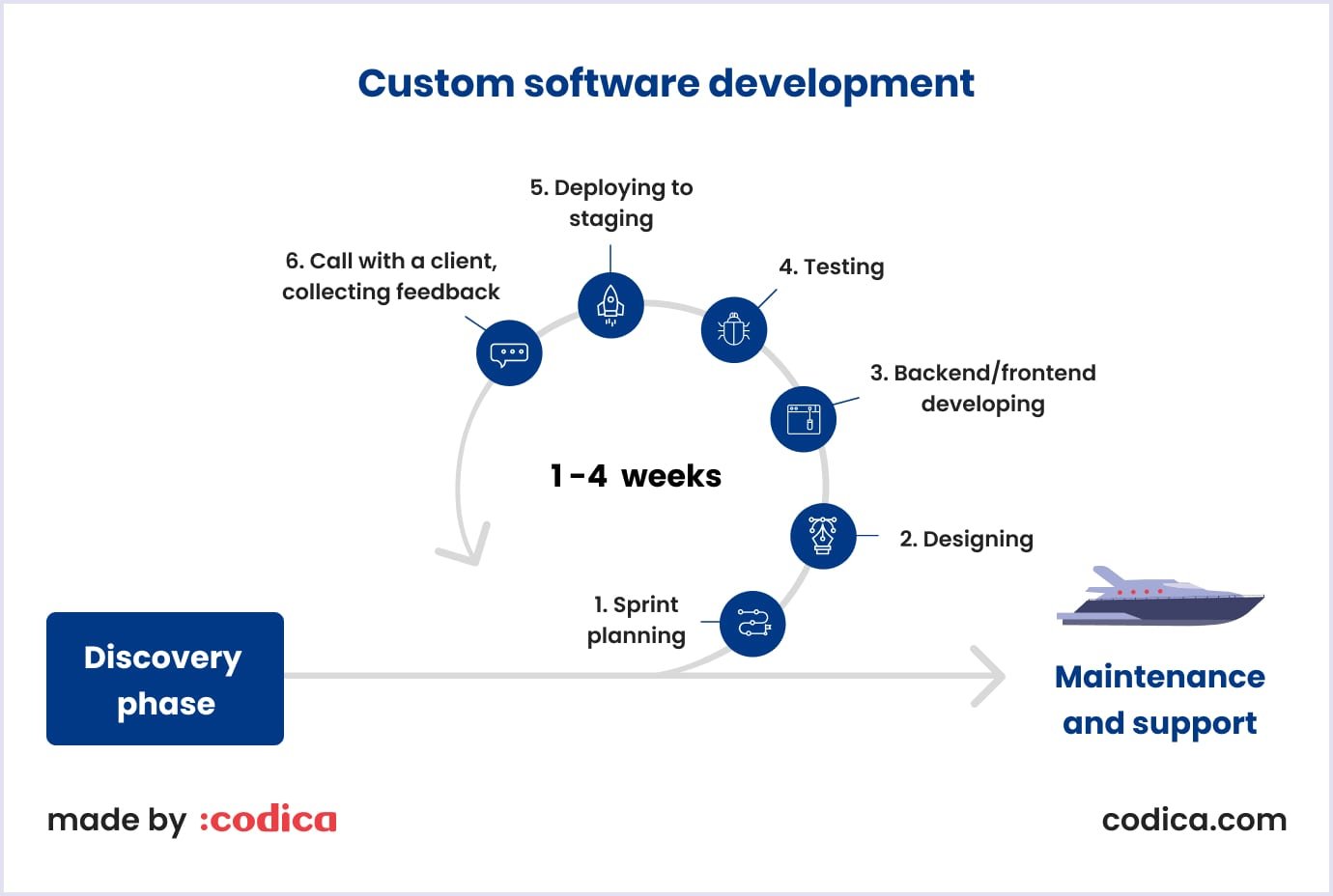
Our development process is divided into stages. These are the project discovery phase, designing, developing, and testing. We also provide maintenance and support of the delivered web product. By the way, you can read more about our development process here: How to Create a Successful Custom Web Product Step by Step: Codica's Experience.
Surely, you have a few options for healthcare application development. You can apply to a professional web development team, like us, or select a cheaper option. The last one is using a template-based solution like Adobe Commerce, for example. However, this variant has its disadvantages, such as the same design and limited functionality.
Whether you choose a custom healthcare app development or a ready-made solution, check the reviews on GoodFirms and Clutch. Also, contacting previous clients of your future healthcare mobile app development partner will be helpful. Why? In such a way, you can make a more informed decision and pick the best software development partner.
Tech stack for healthcare app development
Our web development team has huge experience in building high-performing and reliable software. So, we recommend the tech stack that ensures stable healthcare app work. It comprises the following technologies:
- Frontend: Next.js framework (React-based);
- Backend: Node.js or Ruby on Rails;
- Database: PostgreSQL;
- Search: Elasticsearch;
- Cloud hosting: Amazon Web Services (AWS);
- Integrations: GitLab, Stripe, Sentry.
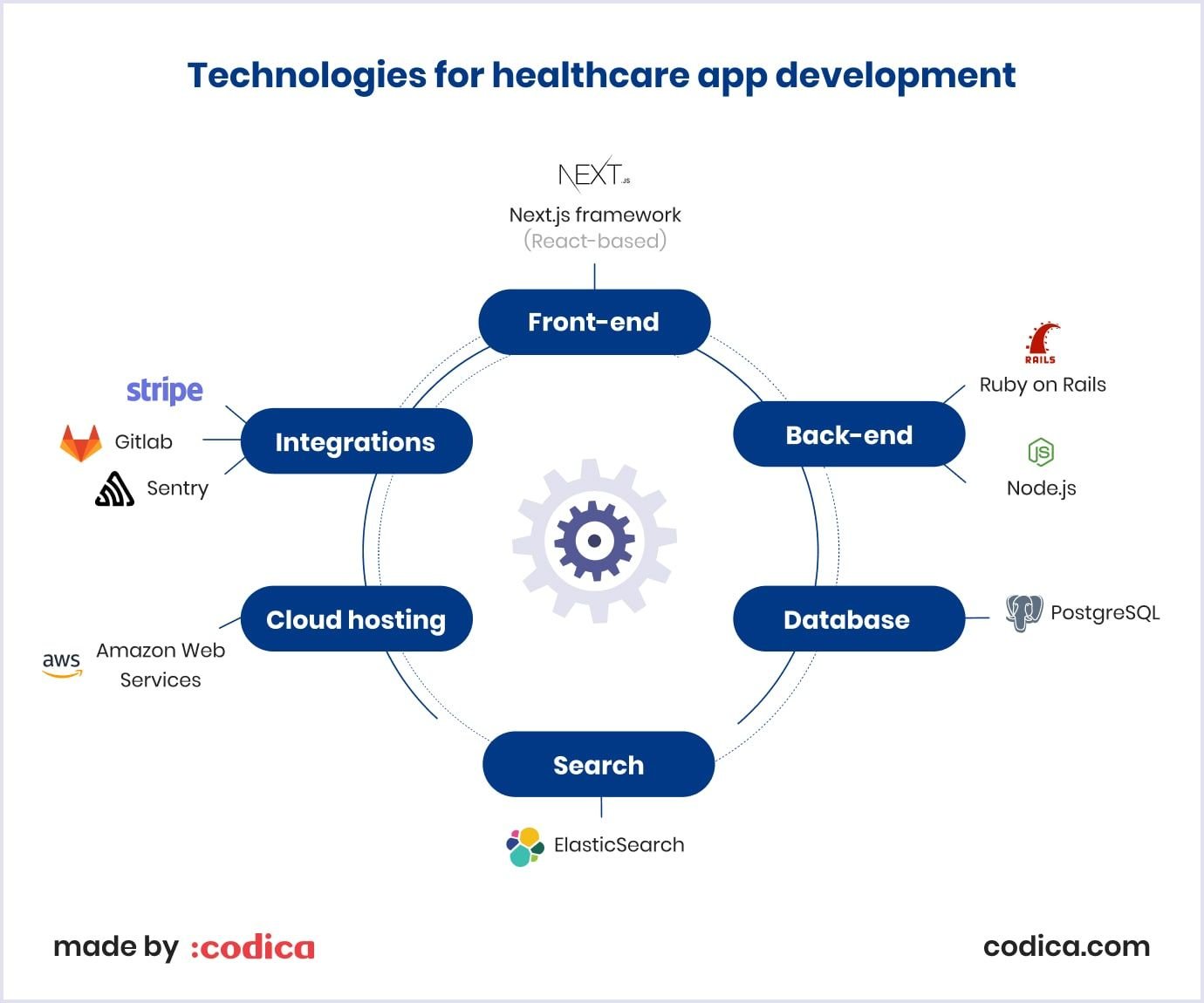
Aspects to consider in healthcare mobile app development
When developing a healthcare app, consider certain aspects to make it reliable and delightful for the target audience. The following aspects that correspond to our healthcare app development process will help you reach that goal.
Product discovery
We recommend you start with the project discovery phase to understand your app’s unique value proposition, target audience, monetization strategy, competitors, and other business aspects. When conducting product discovery sessions with the client, we dive deep into their business needs, which shape the tech aspects of the future solution.
Depending on the product discovery outcomes, we suggest our clients prototypes, tech stack, tech team composition, timeline, and cost estimates. Thus, our clients get a full picture before starting the actual development.
UI/UX design
Healthcare apps should support efficient work for professionals and easy use for patients. Thus, the app interface should be simple. Our designers recommend prioritizing the elements and displaying them clearly to make navigation intuitive. Also, the UI/UX design services should consider the different physical and psychological characteristics of people using the app. Thus, it is a must-have that your app supports accessibility features and follows the relevant accessibility standards.
Healthcare app development: Crucial aspects
In healthcare app development, there are several crucial aspects to consider. Let’s discuss them in more detail, so your app is modern, compliant, and secure.
Interoperability
As we mentioned above, interoperability means that an app can exchange data with other systems. Interoperability has been a significant concern in the healthcare app market. To relieve it, Health Level Seven, a standards organization, released a modern data exchange protocol, FHIR. It is the foundation of the SMART on FHIR framework, which provides a standardized API and authentication model that allows third-party apps to connect safely to electronic health record (EHR) systems. Using it, developers can ensure data consistency, security, and compliance.
Integration with third-party applications through API
Integration with third-party services in a healthcare mobile app reduces development costs. Why? Because you don’t need to develop services from scratch. Also, APIs help to migrate legacy systems to modern platforms without creating custom workflows. The top APIs for healthcare apps include the following:
- Google Cloud Healthcare: helps manage and analyze data from a range of systems.
- eVisit: for scheduling and managing appointments.
- Particle Health: allows healthcare app developers to access patient records and insurance data.
- Apple Health Records: encrypts, verifies, and aggregates data from EHR systems on iOS devices.
Security
Security leaks may cost healthcare mobile app owners a fortune. To make your app secure, use the best safety practices. They include multi-factor authentication, strong encryption, and storing health data in backups. Also, apply a principle of the least privilege to control operations that your app normally does.
Moreover, end-to-end encryption of data in transit limits access to authorized users only. This is a must for apps processing health and personal information.
Local and international regulations
Healthcare apps must comply with regulations protecting users’ personal data and health information. Each country has a standard that regulates the collecting, processing, and storing of people’s data in the healthcare mobile app. So, if you decide to develop a healthcare app, check the relevant regulations in the region where the app is expected to work.
Also, global standards apply, such as ISO/IEC 27001 for information security management and SOC 2 (Service Organization Control Type 2) by the American Institute of Certified Public Accountants (AICPA) for data privacy.
Testing
Mobile app testing helps check the app's look and performance across various devices and operating systems. Healthcare apps track medication intake and are used in emergencies; they handle massive personal data. Thus, quality assurance services for a health app are especially important and must ensure its seamless work. Such tests include compliance testing, security audits, and usability testing with healthcare professionals.
Maintenance and support
Your healthcare app needs constant, careful vigilance for new features and security updates. Thus, your tech vendor should assist you in these matters. For example, our team ensures a secure environment for app development from the start.
Our DevOps tools ensure that we start and finish development with modern technologies that provide speed and cost efficiency. When the time comes to maintenance and support, they help us spot vulnerabilities in an app and address them efficiently and ASAP.

Cost for healthcare app development
Now, we approached one of the most crucial questions. So, how much does it cost to develop a medical app?
The cost of healthcare mobile app development depends on the type of solution and integrations you want to include. Also, the cost includes the cost of development processes needed to build a healthcare HIPAA compliant app or an app corresponding to similar regulations.
We have prepared a table below to answer the question, "How much does it cost to create the mHealth solution?" The table includes the needed features and steps of healthcare mobile application development.
| The estimated cost of creating a healthcare mobile app | ||
| Features | Time, hours | Cost ($50/h) |
| Design | ||
| UX development | 64 | $3,200 |
| UI development | 96 | $4,800 |
| Architecture | ||
| Project setup | 16 | $800 |
| DB structure | 32 | $1,600 |
| Integrations | ||
| Payment (Stripe or PayPal) | 64 | $3,200 |
| Integration with medical devices | 96 | $4,800 |
| Integration with e-healthcare records | 64 | $3,200 |
| Main functionality | ||
| Authorization and Security | 48 | $2,400 |
| User Profiles | 42 | $2,100 |
| Home page | 84 | $4,200 |
| Search | 64 | $3,200 |
| Video consultation | 160 | $8,000 |
| Symptom checker | 72 | $3,600 |
| Chatbot | 96 | $4,800 |
| Reviews | 40 | $2,000 |
| Health education | 48 | $2,400 |
| Notifications | 48 | $2,400 |
| Maps with routes and geolocation | 64 | $3,200 |
| ePrescription dashboard | 64 | $3,200 |
| Medical billing API | 64 | $3,200 |
| Non-development activity | ||
| Project management | 120 | $6,000 |
| Quality assurance | 108 | $5,400 |
| Code review | 64 | $3,200 |
| Total | 1618 | $80,900 |
The price of $80,900 is valid if you apply to a healthcare app development company in Eastern Europe, for example, Ukraine. If you pick an agency from Western Europe or the US, the healthcare app development costs will be higher.
Surely, as healthcare apps vary in the purposes they serve, the cost will change in each particular case. Consult your healthcare mobile app development partner for an accurate estimate of your app’s cost.

Conclusion
Building a health app is a multi-faceted development process that requires a diligent approach. Healthcare application development involves creating useful functionality that meets the users’ needs. An app for medical professionals should be designed to streamline their work process. With the advanced technologies available nowadays, it is possible to create intuitive and stable health solutions.
The main challenge in creating a healthcare app is data security. The health app stores personal data and health information and processes payments. So, it is vital to use the best security practices to protect users’ health information. This can be ensured by following data protection regulations.
If you want to develop a healthcare solution, and looking for a reliable mobile app development company, contact us. Our web development team has vast experience in providing mobile app development services. These services will delight your customers and meet your business needs.
